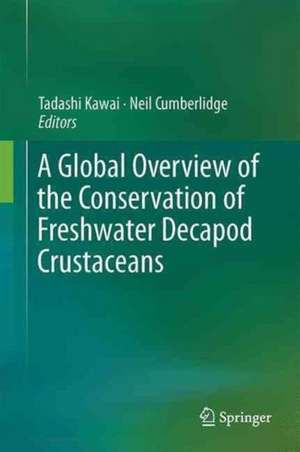A Global Overview of the Conservation of Freshwater Decapod Crustaceans
Editat de Tadashi Kawai, Neil Cumberlidgeen Limba Engleză Hardback – 4 noi 2016
Biodiversity loss in general is highest in organisms that depend on intact freshwater habitats, because freshwater ecosystems worldwide are suffering intense threats from multiple sources. Our understanding of the number and location of threatened species of decapods, and of the nature of their extinction threats has improved greatly in recent years, and has enabled the development of species conservation strategies.
This volume focuses on saving threatened species from extinction, and emphasizes the importance of the successful implementation of conservation action plans through cooperation between scientists, conservationists, educators, funding agencies, policy makers, and conservation agencies.
| Toate formatele și edițiile | Preț | Express |
|---|---|---|
| Paperback (1) | 795.66 lei 38-44 zile | |
| Springer International Publishing – 22 apr 2018 | 795.66 lei 38-44 zile | |
| Hardback (1) | 818.22 lei 38-44 zile | |
| Springer International Publishing – 4 noi 2016 | 818.22 lei 38-44 zile |
Preț: 818.22 lei
Preț vechi: 1076.61 lei
-24% Nou
Puncte Express: 1227
Preț estimativ în valută:
156.59€ • 161.76$ • 130.32£
156.59€ • 161.76$ • 130.32£
Carte tipărită la comandă
Livrare economică 22-28 martie
Preluare comenzi: 021 569.72.76
Specificații
ISBN-13: 9783319425252
ISBN-10: 3319425250
Pagini: 350
Ilustrații: XVII, 430 p. 95 illus., 74 illus. in color.
Dimensiuni: 155 x 235 x 29 mm
Greutate: 0.99 kg
Ediția:1st ed. 2016
Editura: Springer International Publishing
Colecția Springer
Locul publicării:Cham, Switzerland
ISBN-10: 3319425250
Pagini: 350
Ilustrații: XVII, 430 p. 95 illus., 74 illus. in color.
Dimensiuni: 155 x 235 x 29 mm
Greutate: 0.99 kg
Ediția:1st ed. 2016
Editura: Springer International Publishing
Colecția Springer
Locul publicării:Cham, Switzerland
Cuprins
1. Global diversity and conservation of freshwater crabs (Crustacea: Decapoda: Brachyura).- 2. A Remarkable Anomuran: The taxon Aegla Leach, 1820. Taxonomic remarks, distribution, biology, diversity and conservation.- 3. Global diversity and conservation of freshwater crayfish (Crustacea: Decapoda: Astacoidea).- 4. A brief history of freshwater crab research.- 5. Adaptation to life in fresh water by decapod crustaceans: evolutionary challenges in the early life-history stages.- 6. Direct development and posthatching brood care as key features of the evolution of freshwater Decapoda and challenges for conservation.- 7. Freshwater shrimps (Atyidae, Palaemonidae, Typhlocarididae) in the broader Mediterranean region: distribution, life strategies, threats, conservation challenges and taxonomic issues.- 8. Freshwater decapod diversity and conservation in Mexico.- 9. Freshwater decapod diversity and conservation in Central America and the Caribbean.- 10. Diversity, distribution andconservation of freshwater crabs and shrimps in South America.- 11. Biotechnology, biocontrol and conservation: potential approaches – harnessing RNAi-based sex-differentiation manipulations in decapods.- 12. Quantitative habitat models for the conservation of the endangered European crayfish Austropotamobius pallipes complex (Astacoidea: Astacidae).- 13. Conservation First: Strategic planning to save the critically endangered Singapore freshwater crab, Johora singaporensis (Crustacea: Brachyura: Decapoda: Potamidae).- 14. Biodiversity assessment of freshwater shrimps and crabs in the Nee Soon Swamp Forest, Singapore.- 15. Concluding remarks about freshwater decapod conservation.
Notă biografică
Tadashi Kawai
Wakkanai Fisheries Research Institute, Hokkaido, Japan
Neil Cumberlidge
Department of Biology, Northern Michigan University, Marquette, USA
Wakkanai Fisheries Research Institute, Hokkaido, Japan
Neil Cumberlidge
Department of Biology, Northern Michigan University, Marquette, USA
Textul de pe ultima copertă
This book introduces updated information on conservation issues, providing an overview of what is needed to advance the global conservation of freshwater decapods such as freshwater crabs, crayfish, and shrimps.
Biodiversity loss in general is highest in organisms that depend on intact freshwater habitats, because freshwater ecosystems worldwide are suffering intense threats from multiple sources. Our understanding of the number and location of threatened species of decapods, and of the nature of their extinction threats has improved greatly in recent years, and has enabled the development of species conservation strategies.
This volume focuses on saving threatened species from extinction, and emphasizes the importance of the successful implementation of conservation action plans through cooperation between scientists, conservationists, educators, funding agencies, policy makers, and conservation agencies.
Biodiversity loss in general is highest in organisms that depend on intact freshwater habitats, because freshwater ecosystems worldwide are suffering intense threats from multiple sources. Our understanding of the number and location of threatened species of decapods, and of the nature of their extinction threats has improved greatly in recent years, and has enabled the development of species conservation strategies.
This volume focuses on saving threatened species from extinction, and emphasizes the importance of the successful implementation of conservation action plans through cooperation between scientists, conservationists, educators, funding agencies, policy makers, and conservation agencies.
Caracteristici
Summarizes updated species diversity, conservation biology, and conservation actions of freshwater decapod crustaceans Broadens the understanding of diversity and conservation of tropical forest areas Equips readers with the latest information to advance the global conservation Includes supplementary material: sn.pub/extras









